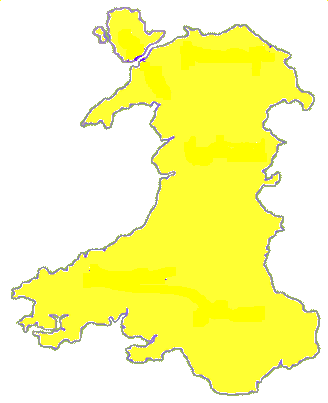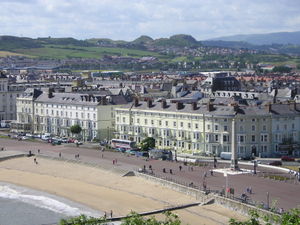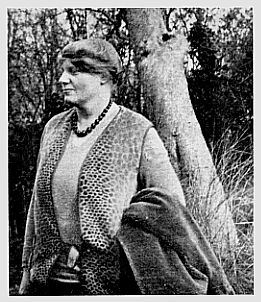

View
of the Llandudno seafront
from
the Great Orme
History of Llandudno
Theosophy and
Llandudno
The Dion Fortune Connection

Dion Fortune
Dion Fortune was born in Llandudno,
North
She was the daughter of
parents with an active interest in the Christian Science and Garden City movements
and the running of hydro-therapeutic establishments. Her interest in occultism
was sparked in 1916 when, as a psychotherapist, she came across the startling
work of Dr. Theodore Moriarty,
who became her first esoteric teacher and inspired her series of short stories The
Secrets of Dr Taverner.
Her interest and involvement in psychoanalysis attracted her
towards the occult by their apparent overlap. She Studied occultism under Dr.
Theodore Moriarty and joined both the Theosophical Society and the Hermetic
Order of the Golden Dawn in 1919, in the Alpha et Omega Lodge run by the
novelist Brodie Innes.
Later she
transferred to Stella Matutina Lodge of the Golden
Dawn run by Moina MacGregor
Mathers and developed mediumship
capabilities in herself whilst continuing the occult/psychological interest.
Her writings
in this period reflect this:
MACHINERY
OF THE MIND THE SOYA BEAN
THE
PSYCHOLOGY OF THE SERVANT PROBLEM
THE
PROBLEM OF PURITY
THE
ESOTERIC PHILOSOPHY OF LOVE AND MARRIAGE
SANE
OCCULTISM
THE
ESOTERIC ORDERS AND THEIR WORK
THE
TRAINING AND WORK OF AN INITIATE
THE COSMIC
DOCTRINE
PSYCHIC
SELF DEFENCE
THE
SECRETS OF DR. TAVERNER (Novel)
THE DEMON
LOVER (Novel)
Her strong
magical-psychological bias was modified by a powerful vision about the need to
take on board the Christian dynamic, and she joined, somewhat reluctantly, the
Christian Mystic Lodge of the Theosophical Society of which she soon become
President. As a result however of strong disapproval of senior figures in the
Theosophical Society, and the Golden Dawn, in her view, becoming moribund, she
founded the Community of the Inner Light, first at Glastonbury and soon also
with a headquarters in London. In 1927 she married Dr. Thomas Penry Evans.
Most of her
subsequent non-fiction work first saw the light of day in The Inner Light
Magazine and her inner development can be followed fairly straightforwardly
from their titles.
AVALON OF
THE HEART
SPIRITUALISM
IN THE LIGHT OF OCCULT SCIENCE
THROUGH
THE GATES OF DEATH
PRACTICAL
OCCULTISM IN DAILY LIFE
MYSTICAL
MEDITATIONS ON THE COLLECTS
THE
MYSTICAL QABALAH
THE WINGED
BULL (Novel)
THE
GOAT-FOOT GOD (Novel)
THE SEA
PRIESTESS (Novel
The novels
were an attempt to give practical exemplification to the theoretical principles
given in her important textbook THE
MYSTICAL QABALAH.
At the
outbreak of war she continued in difficult circumstances, (including being
bombed out of her headquarters temporarily), to keep the Fraternity going with a
series of Weekly Letters and after the restructuring of the group in 1942 in
readiness for the post-war epoch by a series of Monthly Letters, paper
rationing having put a stop to magazine and book publication. She also
continued work on the novel MOON MAGIC. Her writings of this time have been collected
and edited by Gareth Knight under the titles of
THE
MAGICAL
AN
INTRODUCTION TO RITUAL MAGIC
THE
CIRCUIT OF FORCE
PRINCIPLES
OF HERMETIC PHILOSOPHY (which includes "Esoteric Principles of
Astrology"). Teaching upon the Arthurian Tradition that she initiated at this
time has been incorporated into THE
SECRET TRADITION IN ARTHURIAN LEGEND by Gareth Knight.
In early
January 1946 Dion Fortune returned from
Llandudno
Llandudno is a seaside resort and town on the North Wales
coast between Conwy and Colwyn Bay, and at the 2001
census had a population of 20,090 including that of Penrhyn
Bay and Penrhynside, which are within the Llandudno Community. The town is just off the North Wales
Coast railway line which was opened as the Chester and Holyhead
Railway in 1848, became part of the London and North Western Railway in 1859,
and part of the London, Midland and Scottish Railway in 1923. Llandudno was specifically built as a mid-Victorian era
holiday destination and is served by a branch railway line opened in 1858 from Llandudno Junction with stations at Deganwy
and Llandudno.
Llandudno is styles as the Queen of the Welsh Resorts, a
title first implied as early as 1864 is now the largest seaside resort in
Wales, and lies on a flat land between the Welsh mainland and the Great Orme peninsula. Llandudno,
historically part of Caernarvonshire, has been in recent years a part of Aberconwy within Gwynedd and from
1996 has been part of
Modern Llandudno takes its name from the ancient parish of Saint Tudno but also encompasses several neighbouring
townships and districts including Craig-y-Don, Llanrhos,
and
This wide
sweep of sand and shingle extends two miles in a graceful curve between the
headlands of the Great Orme and the Little Orme.
For most of
the distance on Llandudno's
Near the
centre of the bay is the North Wales Theatre and next to it The North Wales
Conference Centre. The Llandudno Yacht Club and a
roundabout mark the end of this section of The Parade and beyond are more
hotels and guest houses but they are in the township of Craig-y-Don.
At Nant-y-Gamar road, The Parade becomes Colwyn Road with the
fields of Bodafon Hall Farm on the landward side but
with the promenade continuing until it ends in a large paddling pool for
children and finally the Craigside residential
development on the lower slopes of the Little Orme.
Llandudno Pier
The town's award
winning pier is on the North Shore; it was built in 1878, and is 1,234 feet in
length and a Grade II listed building.
Looking back
towards the town from the end of the pier, on a clear day one can see the
mountains of Snowdonia rising over the town. A
curious major extension of the pier in 1884 was in a landwards direction along
the side of the Grand Hotel to provide a new entrance with a pier pavilion
theatre at the North Parade end of the promenade, thus increasing the pier's
length to 2,295 feet.
In the
summer, Professor Codman's Punch and Judy show (established in 1860) can be
found on the promenade near the entrance to the Pier.
The Great Orme
This great
limestone headland has many attractions for the tourist including the Great Orme Tramway that takes tourists effortlessly to the
summit.
Two features
of the Great Orme should be mentioned here because
the both start at the end of the promenade where North Parade becomes for a
short distance Happy Valley Road, which in its turn becomes the Marine Drive.
Happy Valley
The Happy
Valley, a former quarry, was the gift of Lord Mostyn
to the town in celebration of the Golden Jubilee of Queen Victoria in 1887. The
area was landscaped and developed as gardens, two miniature golf courses, a
putting green, a popular open air theatre and extensive lawns. The ceremonies
connected with the Welsh National Eisteddfod were held there in 1896 and again
in 1963. In June 1969, The Great Orme Cabin Lift, a
modern alternative to the tramway, was opened with its base station adjacent to
the open air theatre. The distance to the summit is just over one mile and the
four-seater cabins travel at six m.p.h. on a
continuous steel cable over two miles long. It is the longest single stage
cabin lift in Britain and the longest span between pylons is over 1,000 feet.
The popularity of the 'Happy Valley Enertainers' open
air theatre having declined, the theatre closed in 1985 and likewise the two
miniature golf courses closed and were converted in 1987 to create a 280 metre artificial ski slope and toboggan run. The gardens
were extensively restored as part of the resort's millennium celebrations and
remain a major attraction.
Marine Drive
The first
route round the perimeter of the Great Orme was a
footpath constructed in 1858 by Reginald Cust a
Trustee of the Mostyn Estate. In 1872 the Great Ormes Head Marine Drive Co. Ltd. was formed to turn the
path into a carriage road. Following bankruptcy, a second company completed the
road in 1878. The contractors for the scheme were Messrs Hughes, Morris,
Davies, a consortium led by Richard Hughes of Llandudno.
The road was bought by Llandudno Urban District
Council in 1897.[3] The four mile drive (it is one way
only) starts at the foot of the
West Shore
The West
Shore is the quiet beach on the estuary of the River Conwy.
It was here at Pen Morfa that Alice Liddell (of Alice
in Wonderland fame) spent the long summer holidays of her childhood from 1862
to 1871. There are few hotels and a few quiet residential streets. The West
Shore is linked to the North Shore by Gloddaeth
Avenue, a wide dual carriageway.
Mostyn Street
Running
behind the promenade is Mostyn Street leading to Mostyn Broadway and then Mostyn
Avenue. These are the main shopping streets of Llandudno
and Craig-y-Don. Mostyn Street accommodates the high street shops, the major banks and
building societies, two churches, amusement arcades and the town public
library. The latter is the starting point for the Town Trail a carefully
planned walk to facilitate the viewing of Llandudno
in an historical perspective.
Victorian
Extravaganza
Every year in
May Bank Holiday weekend, Llandudno has a great
three-day Victorian Carnival and
Llandudno has a link with Lewis Carroll; because the
family of the "real
Venue Cymru
The North
Wales Theatre, Arena and Conference Centre, built in 1994, extended in 2006 and
renamed "Venue Cymru" is located near the
centre of the promenade on
Llandudno Lifeboat
Llandudno is unique within the United Kingdom in that its
lifeboat station is located inland, allowing it to launch with equal facility
from either the
Early History
of Llandudno
The town of
In 1848, Owen
Williams, an architect and surveyor from

For more info on Theosophy
Try these
Dave’s Streetwise Theosophy Boards
This
is for everybody not just people in Wales
Cardiff Lodge’s Instant Guide to Theosophy
One Liners & Quick Explanations
The Most Basic Theosophy Website
in the Universe
If you run a
Theosophy Group you can use
this as an
introductory handout
The Spiritual Home of Urban Theosophy
The Earth Base for Evolutionary Theosophy
Try these if you are
looking for a
local
Theosophy
Group or Centre
UK Listing of Theosophical
Groups
Worldwide Directory of
Theosophical Links